
Math Assessment in California Schools: The Shift Toward Differentiated Instruction
Math assessment in California is changing. What used to be a compliance exercise or reporting tool is now becoming a...
ALI Staff | Published March 22, 2024
Integrating engineering concepts into elementary education is a crucial topic in this day and age. It's about preparing students for a future where technology and engineering are central.
Exposure to engineering concepts at a young age boosts STEM learning and builds a problem-solving mindset, which is key for tomorrow's innovators.
Engineering makes the world of technology clear and interesting to young learners.
It turns complex ideas from math and science into practical, real-life projects. This process sparks creativity and encourages working together, teaching students the value of learning from mistakes.
This approach doesn't just make their learning journey richer; it gives them the tools and critical thinking skills they'll need in the 21st century.
Read this blog to:
Let's discover how we can make engineering an integral and exciting part of elementary education, offering a lively and diverse learning experience for our students.
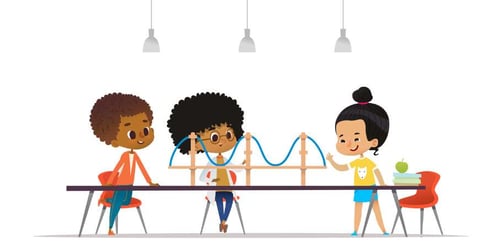
Teaching engineering in elementary schools is crucial. It prepares students for a future filled with technology.
Introducing young learners to engineering concepts boosts their excitement in STEM and builds their problem-solving skills, which is key for future innovators.
Elementary engineering classrooms are hubs of discovery and innovation. Students are budding engineers, diving into projects that resonate with their lives and the world around them.
In these busy classrooms, engineering melds seamlessly with the broader curriculum, enhancing every learning experience.
This method readies students not only for potential STEM pathways but also equips them with the skills to navigate life's challenges.
They learn the power of approaching problems with determination, creativity, and cooperative spirit.
The DIVE-In method reshapes how elementary-aged students encounter engineering, offering a dynamic, hands-on approach that mirrors real-world engineering processes.
This method unfolds through four key phases: Deconstruct, Imitate, Vary, and Explore.
Each phase is designed to build upon the last, fostering a deep understanding and appreciation for engineering from the ground up.
The journey begins with "Deconstruct," where students, acting as "student engineers," break down a prototype.
This phase is foundational, allowing students to see the inner workings of a device or system firsthand.
They engage in active observation and analysis, taking measurements, drawing diagrams, and recording observations.
The hands-on exploration in this step is vital for developing a basic understanding of engineering principles. It teaches the importance of observation and documentation, essential skills for any engineer.
After deconstructing, students move to the "Imitate" phase, using their observations to replicate the prototype.
This step reinforces their understanding by putting theory into practice.
By building an exact replica, students solidify their grasp of the design and function of the original model.
This phase is not just about copying; it's an exercise in precision, attention to detail, and following complex instructions. It introduces students to reverse engineering, showing how engineers often work backward from the finished product.
With a solid understanding of the prototype and replication experience, students now enter the "Vary" phase.
They are encouraged to modify their replicas or use their newfound knowledge to create something new.
This phase applies creativity to engineering principles, encouraging students to think outside the box.
Changes in design, materials, or function can lead to different outcomes. Students learn that engineering is not just about following a blueprint but about innovating and solving problems creatively.
In the final phase, "Explore," where students use their skills, knowledge, and creativity to design and build something entirely new.
This phase challenges them to apply what they've learned in novel situations, fostering a deeper understanding of engineering as a dynamic and creative process.
It's an opportunity for students to become true innovators.
This step emphasizes the importance of experimentation, critical thinking, and the application of knowledge.
The DIVE-In Method provides a comprehensive platform for engineering principles while encouraging creativity, problem-solving, and critical thinking.
By guiding students through its four steps, it not only educates but inspires, preparing the next generation of engineers and innovators.
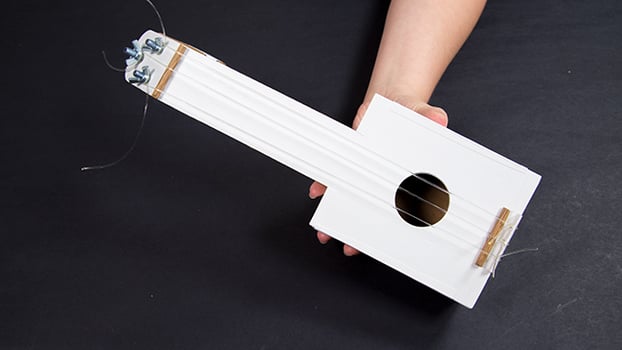
Let’s look in depth at an engineering activity using the DIVE method.
In this step, the teacher helps students understand the instrument and how it works by closely examining a model.
The aim is for students to get a clear picture of what they need to do to build their own stringed instrument, starting with understanding all the parts and materials involved.
During this phase, student engineers take the crucial step of recreating the stringed instrument they previously deconstructed. This process is straightforward and focuses on applying their observations to build a replica of the prototype.
Gathering Materials
Building the Instrument
Reflecting on the Process
This phase is about more than just building; it's a hands-on learning experience that reinforces the students' understanding of engineering principles through the act of creation.
In the "Vary" phase, student engineers are encouraged to creatively modify their stringed instruments.
This phase is about innovation and applying what they've learned to make something unique.
Brainstorming for Innovation
Ideas for Variation
Group Selection and Building
Reflection and Sharing
Upon completing their variation, each student fills out a Project Reflection Document, assessing their own work and then getting peer feedback.
During this phase, student engineers embark on a journey to invent something entirely new, leveraging the knowledge and skills they've acquired.
This final step is about pushing boundaries and applying their learning in innovative ways.
Brainstorming New Ideas
Creative Challenges
Material Gathering and Group Formation
Building and Reflecting
Sharing and Evaluation
This phase embodies the essence of engineering—using science and creativity to invent solutions to real-world problems.
It's a culmination of the DIVE-In Method, showcasing how elementary students can not only understand engineering concepts but also apply them in imaginative and meaningful ways.
Exploring the DIVE-In Method through the Stringed Instrument project offers just a glimpse into the world of elementary engineering.
Let's expand our horizons with more engineering adventures.
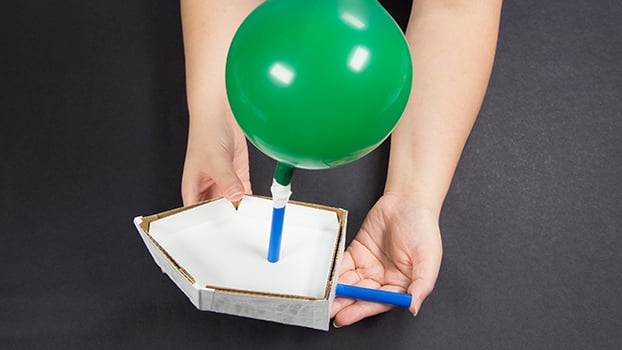
The Balloon Boat project invites student engineers to dive into the history and mechanics of maritime transport.
Starting with a prototype, groups deconstruct and then recreate their own balloon-powered vessel, exploring the principles of air propulsion.
As they reconstruct their own balloon-powered boats, students delve into the physics that allows objects to float and move.
Students experiment with the size and shape of their boats and explore different materials to see how these changes affect buoyancy and speed.
This hands-on activity is not just about constructing a boat; it's an exploration of the principles that govern its movement. Students are then challenged to invent new methods of propulsion, applying their understanding in innovative ways.
This project is a deep dive into physics, fostering creativity and problem-solving skills in young engineers.
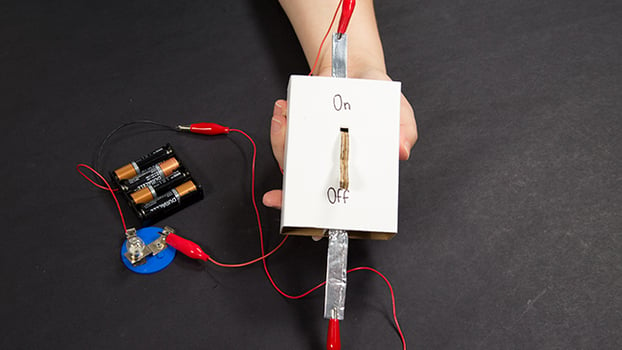
The Light Switch project introduces students to the fundamentals of electrical circuits by guiding them through building a simple switch.
This exploration starts with understanding how electricity flows and the crucial role switches play in managing this flow in everyday devices.
Students are then encouraged to rethink switch designs, perhaps by changing how the switch is activated or using unconventional materials to alter its functionality and appearance.
The journey continues as they conceptualize devices that could be operated by a switch, expanding their grasp of electrical circuits and their real-world applications.
This project melds technical electrical knowledge with imaginative design, igniting curiosity and innovation.
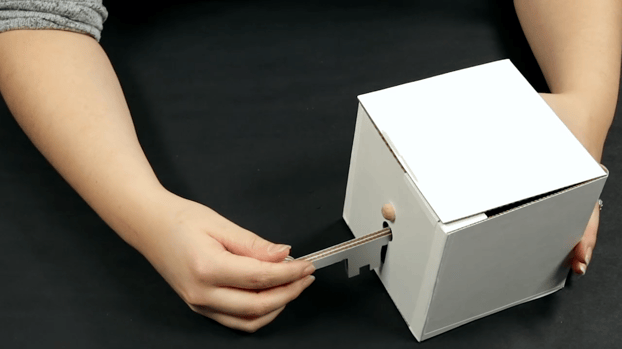
The Lock Box project immerses students in the engineering design process, with a focus on the mechanisms that protect our valuables.
After taking apart and replicating a basic lock box, they're prompted to reimagine its design and functionality.
Students explore how different locking mechanisms can provide various levels of security or ease of use and consider the impact of the box's size on its utility.
The project progresses as students are invited to devise new ways to safeguard items or to tailor a lock box for a particular treasure, applying their insights into materials and mechanisms.
This engineering project not only imparts engineering fundamentals but also fosters a spirit of innovation in security, prompting students to ponder the purpose behind the lock.
Engineering in elementary schools does more than teach learners about technology.
It opens up a world of creativity and future careers for our youngest students while building critical thinking, teamwork, and creativity skills.
This journey isn't just about making things; it's about preparing young minds to think like engineers, ready to tackle tomorrow's challenges.
Let's keep encouraging our students to explore, innovate, and dream big as they build their path in the world of STEM.

Math assessment in California is changing. What used to be a compliance exercise or reporting tool is now becoming a...

You know the moment: a student’s eyes light up when the science experiment fizzes or the math puzzle helps them...

STEM classrooms are full of different types of learners in the classroom, each with their own strengths and needs.
...